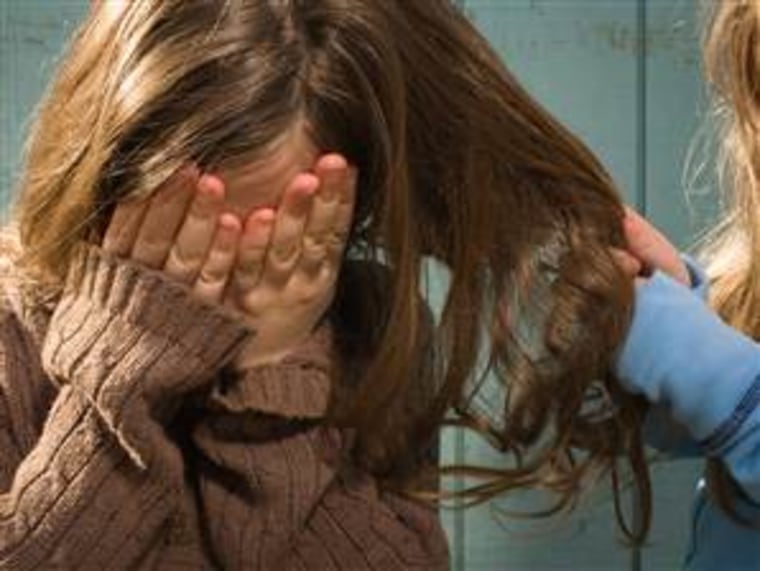The young sisters played outside together every day that summer in a Vallejo, Calif., suburb, and during one long, boring summer day, the older girl thought of a new way to pass the time. She led her little sister to the backyard, tethered the 9-year-old to one of the poles on the back porch, then taped her eyelashes to her eyebrows and left her there to stare into the bright California sun.
That's the account of Nancy Kilgore, now 63 and living in Sacramento, who says she doesn’t remember feeling physical pain that day. She just remembers feeling helpless. “I just basically got to a point where I accepted anything my sister said or did,” says Kilgore.
Back then, Kilgore didn't know she was a victim, but she says she believes now that she grew up as a bullied sibling, a group that's drawing new attention from doctors and researchers who warn parents that such childhood battles may not be as benign as many believe.
The anti-bullying movement has exploded in the last decade and a half – every state but Montana has now passed some sort of anti-bullying legislation, the first being Georgia’s in 1999. Bullying as it's typically understood takes place between unrelated peers – it’s kids being cruel at school, taunting each other or beating each other up.
But a new study published Monday in the journal Pediatrics is a reminder that bullying also happens at home, between brothers and sisters. And, as with peer bullying, sibling bullying is also harmful to a child or teenager’s mental health, the new research finds.
“Historically, sibling aggression has been unrecognized, or often minimized or dismissed, and in some cases people believe it’s benign or even good for learning about conflict in other relationships,” says Corinna Jenkins Tucker, lead author of the paper and an associate professor of family studies at the University of New Hampshire.
“That’s generally not the case in peer relationships. There appears to be different norms for what is accepted. What is acceptable between siblings is generally not acceptable between peers.”
The mental health consequences of bullying between siblings are real, researchers say. Tucker’s report used data from The National Survey of Children’s Exposure to Violence, a phone survey that collected the experiences of 3,599 children aged 1 month to 17 years who had at least one sibling younger than 18 living in the household at the time of the interview. One child was randomly selected to be the subject of three telephone interviews.
Children ages 10 to 17 answered the questions themselves; for children younger than 10, the parents answered the questions. (Tucker acknowledges this is a potential limitation of the study, as parents may not know as much about sibling conflicts as they might think -- particularly if the children share a bedroom.)
The interviewers asked about incidences of sibling aggression in the past year, and they also assessed mental health by asking how often the children experienced anger, depression and anxiety.
Of the children interviewed (or interviewed by proxy), 32 percent reported experiencing at least one type of sibling victimization in the past year. Researchers found that “all types of sibling aggression, both mild and severe, were associated with significantly higher distress symptom scores for both children and adolescents,” the study authors write.
At school, the lines are much more defined: If a kid punches or kicks or relentlessly teases another kid in his or her class -- that’s bullying. But at home, if a brother or sister does the same, it might be dismissed as just another sibling squabble. The difference between normal sibling shenanigans and sibling aggression is a little murky.
“The accepted attitude is, ‘Well, children will be children,’ and that this is a normal rite of passage for being a human being,” says Kilgore, who writes the blog Sibling Bullies and has written a book about bullying.
And that’s true, in a way. If you have a brother or sister, he or she is probably the first person you ever fought with. That can be a good thing, Tucker says – most sibling conflicts and competitiveness are normal, and they can teach children constructive ways of fighting and negotiating.
John Caffaro, a psychologist in private practice in Del Mar, Calif., a San Diego suburb, says one of the biggest red flags signaling sibling bullying is this: One child is always the aggressor, and another child is always the victim. Parents should also look for signs of aggression that aims to leave the other child feeling humiliated or defeated.
Moving forward, Tucker hopes some of the many anti-bullying programs that exist today will begin to include a focus on sibling aggression.
Children who were bullied by a sibling, but not at school, fared a little better than the children for whom the opposite was true, the study showed. Still, the emotional impact of being bullied in your own home, by a brother or sister you trust or look up to, isn’t easily dismissed.
“Think about it: You may be sharing a room with your worst enemy. That’s much worse than meeting this bully once a week at school,” says Caffaro, who has written several books on sibling abuse, including “Sibling Abuse Trauma,” which will be published this fall. “Also, this brother or sister knows you better than anyone else, so they know how to get to you quickly.”
Kilgore says that as a small child, the bullying was all the more hurtful because, as mean as her sister got, she couldn't stop loving her. Her family disputes her account of bullying, says Kilgore, and she cut off contact with them a decade ago.
But back then, “I was in love with her," Kilgore says. "I just adored my sister.”
